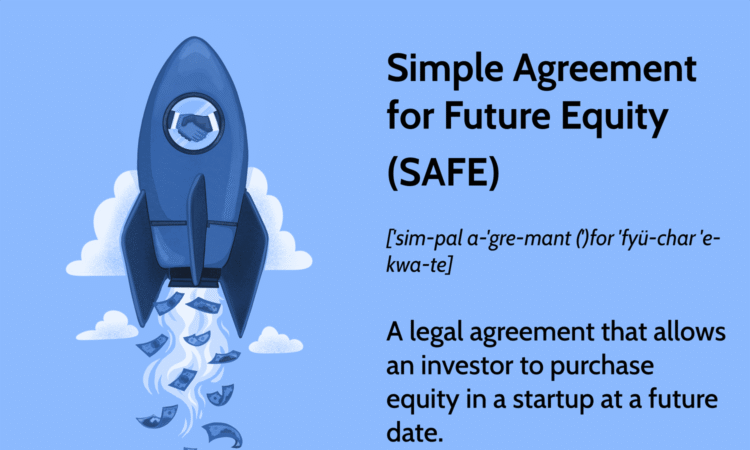
What Is a Simple Agreement for Future Equity (SAFE)?
A simple agreement for future equity (SAFE) is a financial instrument first offered in 2013 that has gained popularity in the startup ecosystem, particularly among early-stage companies.
SAFEs do not represent a current equity stake in a company. However, SAFEs typically convert into company shares after a triggering event, such as when the startup raises funds in a real investment round, gets acquired, or goes public.
Key Takeaways
- Simple agreements for future equity, or SAFEs, are flexible agreements providing future equity rights without immediate valuation.
- SAFEs are commonly used for early-stage startup funding.
- Conversion terms are triggered by specific events like equity funding rounds or acquisitions.
- They differ from traditional financing methods, not accruing interest or having a maturity date.
How SAFEs Work
SAFEs emerged as a popular fundraising option after 2013 when Y Combinator, a tech startup company, introduced it. Since then, they have become more widely used, especially among early-stage startups, as a more straightforward and faster alternative to equity financing or convertible notes.
Startups use SAFEs to receive funding without determining a valuation or issuing equity immediately. Investors invest in the startup, rather than getting shares right away. Their investment converts into equity only once a predefined triggering event occurs.
Common triggering events, also known as conversion terms, include an equity financing round, an acquisition, or an initial public offering (IPO). Conversions usually happen at a discount or valuation cap as an incentive to invest early.
A SAFE has no interest and no maturity date. If there’s no priced round, the SAFE can remain outstanding until a liquidity or dissolution event, at which point the SAFE’s contract dictates cash-out or conversion.
Note
A SAFE is not a loan; it doesn’t accrue interest and doesn’t have a maturity date. This makes it different from traditional financing models.
Benefits of a SAFE
SAFEs have several benefits for both the startup and the investor. For both parties, the most significant advantage is their simplicity.
SAFEs are typically shorter and less complex than traditional equity or debt financing documents, which speeds up the negotiation process. This enables startups to focus on their business rather than getting bogged down in lengthy funding negotiations.
SAFEs also often have customizable terms that can be tailored to fit the specific needs of the startup and its investors. This flexibility can include valuation caps and discount rates, allowing startups to negotiate terms that align with their growth strategy and funding needs.
Since investor returns are directly tied to the equity they receive, their success is aligned with the startup’s success. This can encourage investors to contribute more than just capital. They might offer mentorship, industry contacts, and strategic advice to help the startup succeed.
Benefits for Startups
Startups often struggle with accurate and fair valuation in their early stages. SAFEs let them postpone this challenge until a later funding round, usually when more information is available to determine the company’s worth. This can prevent founders from undervaluing their company early on.
Early-stage funding rounds can also lead to significant equity dilution for founders. SAFEs can be structured to lower this dilution compared with traditional equity financing, enabling founders to keep more control over the company.
Unlike convertible notes, SAFEs are not debt instruments and don’t accrue interest. This aspect is helpful for startups since it avoids the pressure of accumulating debt and the obligation of making repayments. This can be challenging for companies still working on generating revenue or with high burn rates.
Benefits for Investors
For investors, the primary attraction of a SAFE is the potential for high returns. If the startup succeeds, its equity could appreciate substantially.
Since SAFEs are used primarily in early-stage startups, the initial investment is typically lower than in later funding rounds. This lower entry point reduces the risk for investors while still allowing them to be part of a potentially successful venture.
In some cases, SAFEs can include provisions that give early investors some priority over future investors. This can consist of early access to new shares or discounts in future rounds, which can attract investors looking to maximize their investment benefits.
SAFEs also have a straightforward exit strategy. Once the agreement is converted into equity, investors can stay invested or exit through secondary sales, an acquisition, or an IPO of the startup.
Risks and Considerations of SAFEs
When a startup defers its valuation to a later round, there’s a risk that it will become overvalued. If the company doesn’t meet its expected growth benchmarks, it might face difficulties raising funds or satisfying investor expectations based on the agreed-upon cap.
While SAFEs initially lower the risk of dilution, converting these instruments into equity during subsequent funding rounds can dilute the founders’ stakes later. This could be more than originally anticipated, especially if the startup has to raise more funds at a lower valuation.
For investors, SAFEs don’t provide immediate ownership in the company. This means investors won’t have equity or voting rights until the SAFE converts, which might not happen if the company doesn’t survive until its later funding round. If the startup fails before the conversion event, SAFE investors may end up with nothing. Unlike debt instruments, SAFEs typically don’t protect investors like creditors if there’s a company liquidation.
Important
In some cases, triggering events in a SAFE might not occur, leaving investors without equity. For instance, if a startup becomes financially self-sufficient, no longer requires additional funding, and isn’t acquired by another entity, then the conditions for converting the SAFE into equity might never be met. This scenario could mean the investor doesn’t receive equity despite the initial investment.
SAFEs vs. Other Early-Round Financing Instruments
To better understand SAFEs, it’s helpful to survey the landscape of startup financing and compare the instruments commonly available to entrepreneurs and early-stage investors. Each carries its own set of features, benefits, and considerations. This table offers a concise yet comprehensive overview, highlighting the key differences in structure, conversion mechanisms, and investor rights.
| Early-Round Financing Instruments | ||||
|---|---|---|---|---|
| Feature | SAFEs | Convertible Notes | Equity Financing | Loans |
| Structure | Contractual right to future equity; not debt. | Debts that convert to equity | Direct ownership in company | Debt |
| Conversion to Equity | At next funding round or liquidity event, often with valuation cap or discount | Convert at specified triggers, often with interest and discount | Immediate equity issuance | Do not convert to equity |
| Interest Accrual | No | Yes | No | Yes |
| Maturity Date | No maturity date | Have a maturity date | N/A | Have a maturity date |
| Investor Rights | Limited until conversion | Creditor rights until conversion, then equity rights | Immediate equity rights (voting, dividends) | Creditors’ rights |
| Valuation Determination | Deferred until conversion | Can be determined at conversion | Determined at investment | N/A |
| Immediate Equity | No | No, until conversion | Yes | No |
| Debt Obligation | No | Yes, until conversion | No | Yes |
Legal and Regulatory Considerations of SAFEs
From a legal standpoint, a SAFE is a contract that gives investors the right to receive equity in the future if a triggering event occurs. Because SAFEs are considered securities, companies that issue them must comply with federal and state securities laws. Most private startups do this by using a Regulation D exemption and filing a Form D with the SEC within 15 days of the first sale. Some states also require separate “blue-sky” notice filings.
Note
It’s crucial to consult with legal and financial experts to understand the full implications of a SAFE, including potential tax consequences and compliance with securities laws.
For investors, SAFEs don’t usually entail voting rights. However, agreements may grant voting rights on specific matters related to the SAFE. Some SAFEs may include terms allowing the company to repurchase the investor’s future equity rights instead of conversion. Should the company be dissolved, the terms will state what happens to the investments in the SAFE, which could include a total loss.
What Is the Valuation Cap in a SAFE?
A valuation cap in a SAFE sets the maximum value in equity you can get in the agreement. If the company’s valuation when a triggering event (like a funding round) occurs is more than the cap, then your SAFE is converted using the valuation cap’s value. This can result in you receiving more shares. The cap is designed to reward early investors for taking on more risk by getting in at an earlier stage.
What Is a Pre-Money vs. Post-Money SAFE?
Whether a SAFE is labelled pre-money or post-money comes down to whether the company includes the SAFEs in its valuation cap. The valuation cap is the maximum company value that will convert the SAFE into equity down the line, and it helps determine how much ownership the investor ends up with.
With a pre-money SAFE, the valuation cap is calculated before including the SAFE investments (or other convertible securities) in the company’s capitalization. As a result, SAFE investors don’t know their exact ownership percentage at the time of investment.
With a post-money SAFE, the valuation cap is calculated after including the amount raised via SAFEs (i.e., the SAFE round is treated as part of the cap). Post-money SAFE investors have a clearer, more immediate idea of their ownership percentage once the SAFE converts.
How Is a SAFE Taxed?
While the initial investment amount into a SAFE would not cause any tax liability for the investor when investing, its conversion into equity means it becomes taxable. When the SAFE is converted into equity shares, any gains above your original investment are subject to capital gains tax should you sell your shares. For the company, although a SAFE is not treated as debt or equity at first, the cash received from investors is generally considered investment capital, not taxable revenue, when issued.
Can a SAFE Be Used at a Later Funding Round?
SAFEs are typically associated with seed-stage funding, given their simplicity and the flexibility they provide to manage an uncertain valuation. While uncommon, they can be adapted for use in later funding rounds. The key is to tailor the SAFE terms to suit the more mature stage of the company by adjusting the valuation cap and discount rate to reflect the company’s growth and market conditions.
How Does a SAFE Impact a Startup’s Cap Table?
A SAFE influences a startup’s capitalization table (cap table) at the time of conversion, not when the SAFE is initially issued. This means that the investor’s potential equity stake is not immediately reflected in the cap table. Once there is a triggering event like a funding round or a sale, the SAFE is converted into equity, increasing the number of shares outstanding and altering the ownership percentages, potentially diluting earlier investors’ shares.
The Bottom Line
A SAFE is a popular financial instrument in the startup ecosystem, primarily used by early-stage companies. Startups can use it to adapt to changes while securing funding without providing immediate equity stakes or determining a set value for their shares.
SAFEs let investors convert their cash investments into equity when specified events occur, often at a discount or a maximum value. Key benefits include simplicity, customizable terms, aligning investor and startup success, and lowering the potential for diluting founders’ stakes.
However, since SAFEs do not confer any shares or rights until conversion, the investor may lose all their money if the company never reaches the predetermined milestones.



